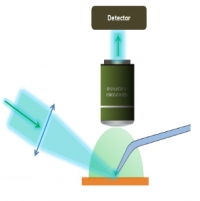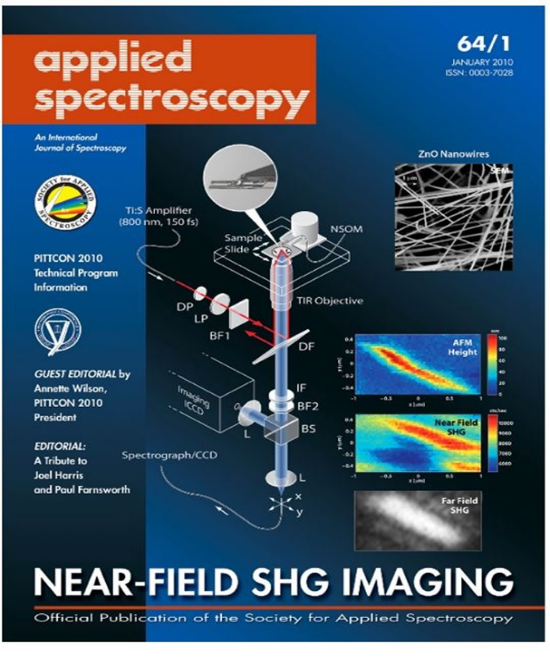NSOM Modes
Apertureless NSOM
Apertureless (or scattering s-NSOM) NSOM is an optical method that overcomes optical diffraction limits in order to obtain optical images with nanoscale resolution. Most convential apertureless NSOM systems use sharp metal coated AFM probes illuminated with a far-field optical source. The electrical field is enhanced at the sharp metallized tip (as in the lightning rod effect) and thus the tip acts as the "hot spot". The optical signal scattered from the probe is extracted from the far-field background using probe modulation methods.
Despite of the high optical resolution, this method has some limitations mainly because of the large background signal, artifacts and delicate measurement equipment. For example, for NSOM in collection mode, fluorescence, photo-luminescence and polarization effects cannot be performed using the apertureless technique with one metalized probe and IR far-field illumination. Apertured NSOM can also be a challenge in the IR spectrum.


Nanonics solutions are based on the unique abilities of the single probe and multi-probe scanning microscopes. Nanonics enables one to adopt the system and the probes for specific applications and to meet the researcher’s needs. One example of this is the use of our Thermocouple or Thermo-resistivity probe; by scanning it over the sample, one can probe the IR optical field in the near vicinity of the sample. This is done without the need of introducing illumination on the tip and it allows one to collect a large spectrum of IR. See an application of this technique below.
Our apertureless technique can be combined inside a Cryogenic or High Vacuum chamber along with simultaneous imaging such as in-situ Raman.
Speak with an application scientist about how Apertureless NSOM can advance your research.
Key Features
IR NSOM with on-line Raman
Instrument and Probes allowing aperturless IR NSOM with on-line Raman vibrational spectroscopic comparison at ambient and controlled environment conditions.

Probes with transparent IR shafts & scattering tips that do not block any ray of the Raman lens.
Propritary Probes with Unique Features
1. Multiple probes can be brought into contact and separated with nanometric precision for investigating nanotransport of conductivity, optical and thermal phenomena:

”Collisions between both tips were effectively prevented by a proximity detection mechanism based on mechanical interaction between both tips. The minimum distance between both tips is reached when both tip coatings touch..” Klein et al, NanoLett. 14, 5010 (2014)
2. Probes are made with a variety of materials to optimize scattering only from the probe tip and not the shaft or cantilever. Probes with transparent IR shafts and scattering tips do not block any ray of the Raman lens.

”…In our experimental configuration, the tip apex is not shadowed, as the laser beam is a focused beam with a converging angle of 26.7o, while the half angle of the tip is only about 4o . “ [Sun and Shen, Apertureless near-field scanning Raman microscopy using reflection scattering geometry, Ultramicroscopy 94, 237 (2003)]
Variable Magnetic Field Readily Integrated
Variable magnetic fields, above or below sample:

Controlled Environment & Low Temperature 10 Degrees K Operation with Similar Characteristics
Fully integrated controlled environment and 10oK conditions multiprobe apertureless.

10X Higher Force Sensitivity Compared to other AFM Feedback Methods

Click here to learn more about AFM and tuning fork technology.
Multiprobe Plasmonic Transport Measurements
Collage produced by combining apertureless images of amplitude & phase of plasmonic transport:


Multiprobe SPM Based Apertureless Optics
 In standard approaches to Apertureless NSOM (ANSOM), the probe functions as a modulated scatter with gross far-field optical illumination using elements such as lenses or mirror, which cause large spot sizes of radiation around the scattering probe. Far-field optical elements create the radiation background. This background can interfere with the desired signal from the nanometric tip of an atomic force sensor capturing the near-field surface component in a large far-field radiation background.
In standard approaches to Apertureless NSOM (ANSOM), the probe functions as a modulated scatter with gross far-field optical illumination using elements such as lenses or mirror, which cause large spot sizes of radiation around the scattering probe. Far-field optical elements create the radiation background. This background can interfere with the desired signal from the nanometric tip of an atomic force sensor capturing the near-field surface component in a large far-field radiation background.
 The Multiprobe Apertureless NSOM enables the reduction of both the optical and mechanical background and thus increases the overall S/N in NSOM experiments. With a multiprobe system, one probe can be used as a limited illumination spot onto a second scattering probe, as shown in the picture to the right. This reduces the optical background and generates the correct k vectors to excite the scattering probe.
The Multiprobe Apertureless NSOM enables the reduction of both the optical and mechanical background and thus increases the overall S/N in NSOM experiments. With a multiprobe system, one probe can be used as a limited illumination spot onto a second scattering probe, as shown in the picture to the right. This reduces the optical background and generates the correct k vectors to excite the scattering probe.
Exemplary Papers
Tuning Fork AFM Feedback with Independently Demonstrated Superior Results
Tuning fork feedback allows for no optical AFM feedback and no optical interference with the measurement. With tuning fork feedback, there is also no jump to contact - which is critical for real oscillation of the tip in the very near vicinity of the sample where the highest enhancement of the optical field occurs.
Published study shows that Nanonics tuning fork AFM feedback is superior to other medthods for scattering NSOM.

Image: Degl’Innocenti, R., Wallis, R., Wei, B., Xiao, L., Kindness, S. J., Mitrofanov, O., ... & Ritchie, D. A. (2017). Terahertz nanoscopy of plasmonic resonances with a quantum cascade laser.
Reference: ACS Photonics, 4(9), 2150-2157.
https://pubs.acs.org/doi/10.1021/acsphotonics.7b00687
Click here to learn more about AFM and tuning fork technology.
Apertureless Imaging with Photon Force (PiFM) in the Visible mid-IR & THz

Above: Collage of topography with shading photon force amplitude
Nanonics user Aristide Degariu used this picoNewton force sensitivity to image with photon force
Reference: Kohlgraf-Owens, D. C., Greusard, L., Sukhov, S., De Wilde, Y., & Dogariu, A. (2013). Multi-frequency near-field scanning optical microscopy. Nanotechnology, 25(3), 035203.
Read abstract here: http://iopscience.iop.org/article/10.1088/0957-4484/25/3/035203
Measuring the Force of a Single Photon with AFM
Nanonics user Aristide Degariu used this picoNewton force sensitivity to measure the force of a single photon with AFM.
Reference: Kohlgraf-Owens, D. C., Sukhov, S., & Dogariu, A. (2011). Mapping the mechanical action of light. Physical Review A, 84(1), 011807.
Read abstract here: https://journals.aps.org/pra/abstract/10.1103/PhysRevA.84.011807
Apertureless Point Detection of Near-field Photon Flux Without A Large Background With A Point Thermocouple

The thermal probes Linear response at different wavelengths
Reference: Grajower, M., Desiatov, B., Goykhman, I., Stern, L., Mazurski, N., & Levy, U. (2015). "Direct observation of optical near field in nanophotonics devices at the nanoscale using Scanning Thermal Microscopy." Optics express, 23(21), 27763-27775.
Read abstract here: https://www.osapublishing.org/oe/abstract.cfm?uri=oe-23-21-27763


Seen above: Nanonics thermocouple probe
Learn more about Nanonics thermocouple probes:
Apertureless Direct Temperature Mapping of Nanoscale Plasmonic Devices
 The steady-state thermal distribution in silicon plasmonic nano-tips is studied numerically and measured experimentally using the approach of scanning thermal microscopy. The Nanonics MV4000 with a Thermal tip was used in order to achieve the high resolution results.
The steady-state thermal distribution in silicon plasmonic nano-tips is studied numerically and measured experimentally using the approach of scanning thermal microscopy. The Nanonics MV4000 with a Thermal tip was used in order to achieve the high resolution results.
The capability of measuring temperature distribution of plasmonic structures at the nanoscale is shown to be a powerful tool and may be used in future applications related to thermal plasmonic applications such as control liquids heating of, thermal photovoltaic, nanochemistry, medicine, heat-assisted magnetic memories, and nanolithography.
Reference: Desiatov, B., Goykhman, I., & Levy, U. (2014). Direct temperature mapping of nanoscale plasmonic devices. Nano Letters, 14(2), 648–652.
About the Author: Uriel Levy is a Professor in Hebrew University of Jerusalem. He is a world leader in nanophotonics and head of the NanoOpto group. His research is mainly focused on Silicon Photonics, Polarization Optics, Plasmonics and Opto-Fluidics. He is the recipient of The Hebrew University President’s Prize for Outstanding Young Researcher and is a fellow of the Optical Society of America. Professor Levy is an Editor of the journal Optics Express, has published more than 90 scientific articles in leading journals, and serves on the committees of several conferences in the field of opto-electronics.
Read abstract here: https://pubs.acs.org/doi/abs/10.1021/nl403872d
Femto Second PiFM Imaging without Thermal Artifacts
 CW laser photon induced force measurements (PiFM) experiments compared with fsec pulsed laser measurements with a Nanonics MV 2000 showing no thermal artifacts.
CW laser photon induced force measurements (PiFM) experiments compared with fsec pulsed laser measurements with a Nanonics MV 2000 showing no thermal artifacts.
CW measurements show wavelength dependent PiFM imaging while fsec PiFM is wavelength independent
Reference: Jahng, J., Park, S., Morrison, W. A., Kwon, H., Nowak, D., Potma, E. O., & Lee, E. S. (2017). Nanoscale spectroscopic studies of two different physical origins of the tip-enhanced force in photo-induced force microscopy. arXiv preprint arXiv:1711.02479.
Read abstract here
Combined Apertureless Near-Field Optical Second Harmonic Generation/Atomic Force Microscopy Imaging and Nanoscale Limit of Detection
 Nano-wires have become of rapid interest with potential for a variety of applications such as nano-lasers and solar energy conversion materials. In this article, ZnO nanowires were investigated when exposed to CO2 gas and water vapor. The SHG spectra was imaged in high resolution in combination with the Nanonics MV4000 apertureless NSOM configuration. SHG is an indication of the symmetry properties of crystals which allow understanding of their polarizability. Different SHG intensities were imaged when exposed to different gaseous environments. Spatial resolution was observed in agreement with the tip characteristics and superior to the optical diffraction limit.
Nano-wires have become of rapid interest with potential for a variety of applications such as nano-lasers and solar energy conversion materials. In this article, ZnO nanowires were investigated when exposed to CO2 gas and water vapor. The SHG spectra was imaged in high resolution in combination with the Nanonics MV4000 apertureless NSOM configuration. SHG is an indication of the symmetry properties of crystals which allow understanding of their polarizability. Different SHG intensities were imaged when exposed to different gaseous environments. Spatial resolution was observed in agreement with the tip characteristics and superior to the optical diffraction limit.
Reference: Meyer, K. A., Ng, K. I. N. C., Gu, Z., Pan, Z., Whitten, W. B., & Shaw, R. W. (2010). Combined Apertureless Near-Field Optical Second-Harmonic Generation / Atomic Force Microscopy Imaging and Nanoscale Limit of Detection. Applied Spectroscopy, 64(1), 1–7.
Read abstract here
About the Authors: Robert W. Shaw is the group leader of the Laser Spectroscopy and Chemical Micro-technology group in ORNL. He has published many articles in the field of spectroscopy and physiology using high resolution techniques.

